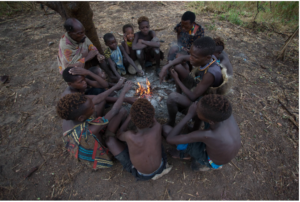Northern Tanzania is home to the Hadzabe, one of the last remaining hunter-gatherer tribes on Earth. Known for shunning material possessions and social hierarchy, the Hadza roam as needed to find game, tubers and wild berries.
Hunter-gatherer societies understand that their survival depends on natural resources. The Hadza’s deep reservoir of natural knowledge and light footprint on their land have enabled them to persist in a challenging environment.
Pressures on the Hadza Homeland
For years, the tribe had been watching their ancestral territory disappear. Whittled away by encroaching pastoralists and agriculture, the boundaries of the wide-open spaces they travel were shrinking, and the Hadza, like other indigenous communities, had no formal claim to ownership.
By analyzing satellite imagery, The Nature Conservancy identified a chain reaction on the ground. Agriculture encroaches mainly from the south, as the Sukuma people clear woodland brush to grow beans and maize. The Datoga pastoralists, driven northward, then graze livestock on semi-arid lands the Hadza rely on to find food.
Unless we act now to secure wildlife corridors and traditional land uses for pastoralists and hunter-gatherers, the vibrant Hadza culture will likely be squeezed out of existence.


Setting a Precedent: Land Rights Protected
Land rights in Tanzania are a complicated issue, but they are extremely important to the future of Tanzania and its people. Communal lands are central to the Hadzabe and other groups, and gaining legal rights to those lands as a community is the first step toward keeping those lands undeveloped.
Our partner Ujamaa Community Resource Team (UCRT), with support from the Dorobo Fund and TNC, pioneered the Certificate of Customary Right of Occupancy (CCRO), a form of individual, and more recently, group land tenure within a larger village holding. This is an effective tool for strengthening community land rights and securing communal lands.
In October 2011, the Hadza took the innovative step of asserting legal claim to their homeland with a CCRO. They received official title — recognized by the government of Tanzania — to 57,000 acres.
In 2012, we secured four more homeland designations and protected 90,000 additional acres for the Datoga tribe. Their designations assert that more than 80 percent of their lands will now be managed as grazing areas for livestock and wildlife.
Securing additional land for pastoral use helps both tribes, as the Datoga no longer need to move onto Hadza land to graze cattle.
Now, the Northern Tanzania Rangelands Initiative, a coalition of 10 NGOs working to create a thriving landscape where people and wildlife co-exist, has helped secure more than 1.2 million acres of land for communities like the Hadza.


An Award-Winning Effort
With legal rights to the land, the Hadza then had the means to earn income from it in a sustainable way. Working with Carbon Tanzania and other NTRI partners, the Hadza established a mechanism that pays them for protecting their traditional forests.
They’ve since earned more than $300,000, which has gone toward paying school fees for dozens of students, training rangers to monitor the community’s land and its wildlife, and improving health clinics. The money also pays to keep the forest protection program running and expanding.
This nature-based solution to helping mitigate the effects of climate change is also preserving a people’s traditional way of life in a modern world. And for this reason, the Hadza’s Yaeda Valley Project is a recipient of the 2019 Equator Prize, one of the United Nation’s most prestigious awards for environmental protection and climate resilience.


